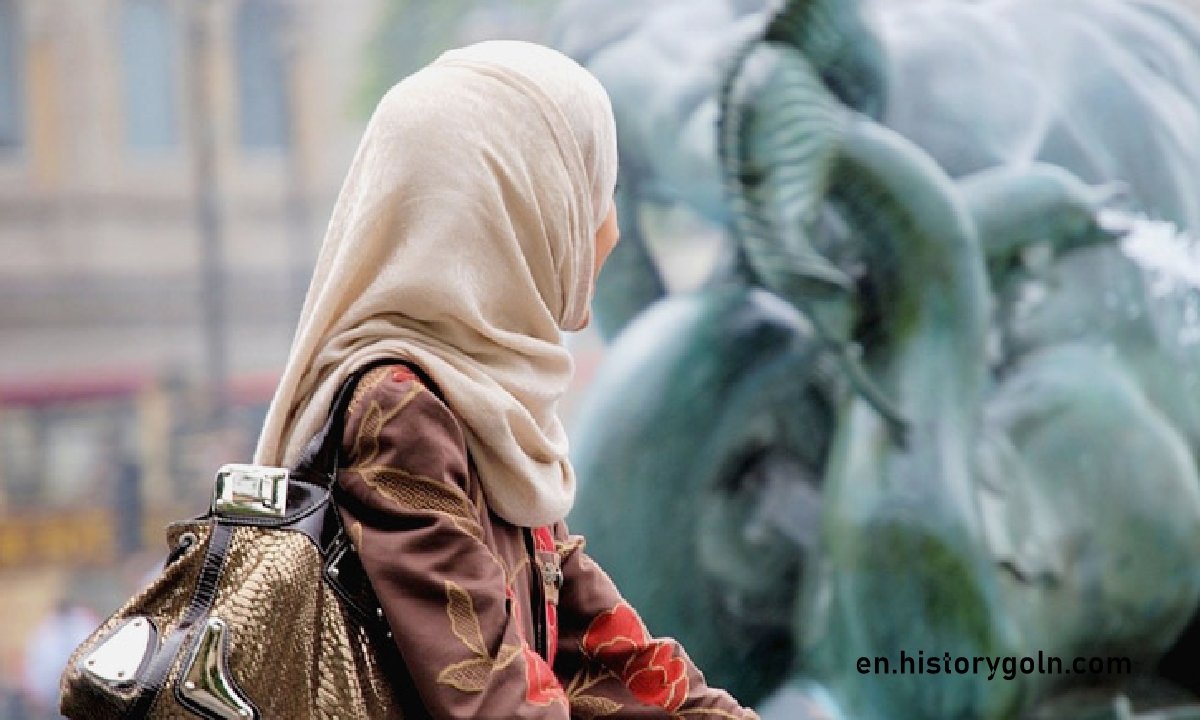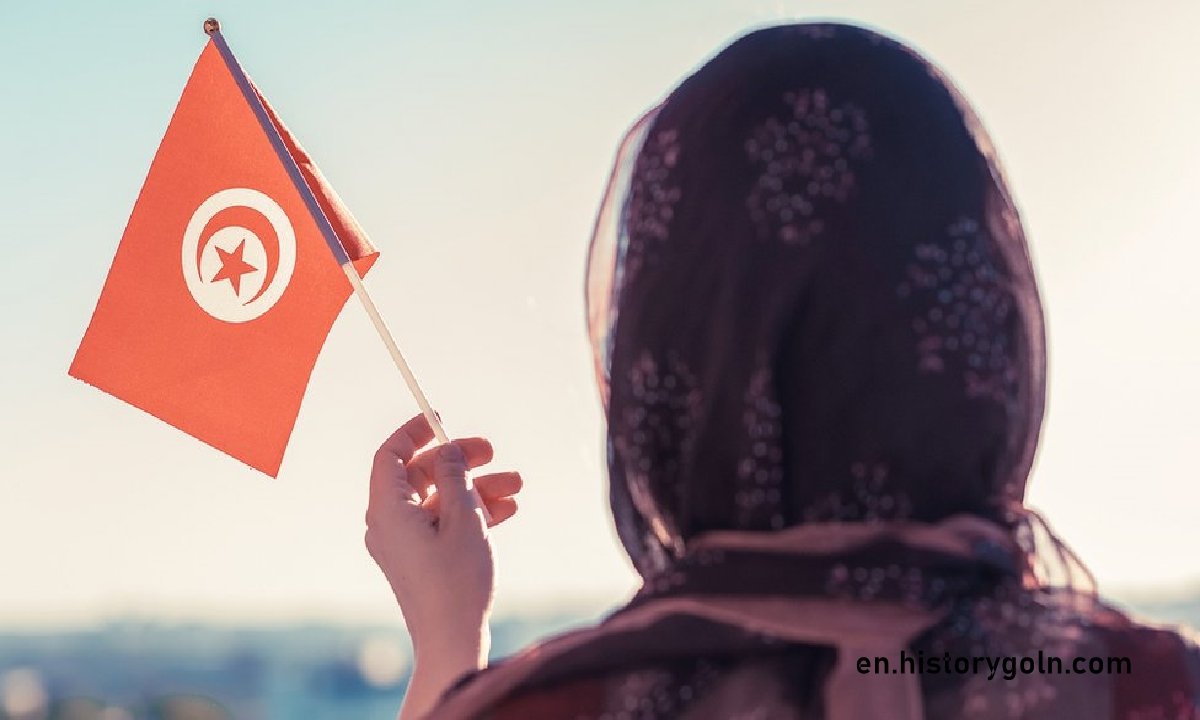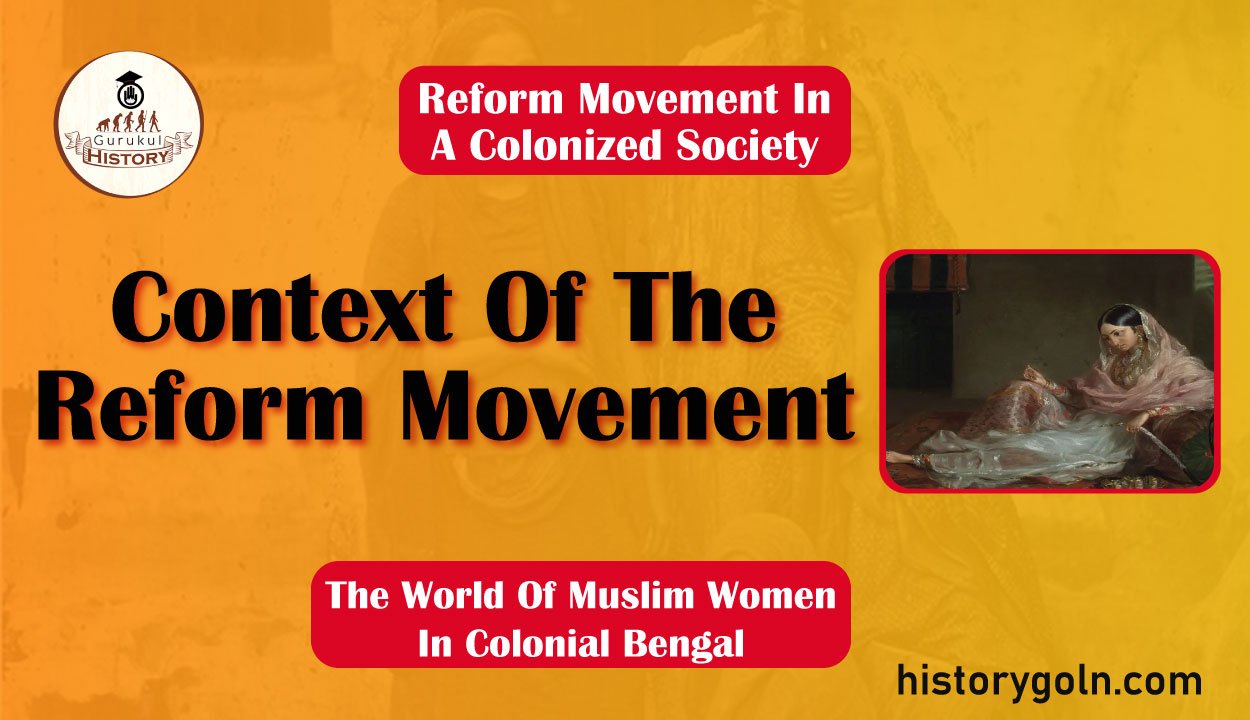Today our topic of discussion is Context Of The Reform Movement .
Context Of The Reform Movement

The women’s question in the latter half of the nineteenth century had to be formulated in a society where the process of modernization was subver- ted by colonization which had disrupted the political, economic and cultural reality of India.
The change had occurred earliest in Bengal which was the first foothold of the British. Changes introduced in the economic infrast- ructure through the introduction of land ownership, commercial agriculture and new forms of business enterprises, were accompanied by transformation of the legal and educational systems, and a dislocation of cultural patterns.
The traditional sources of wealth, power, and prestige for the Muslim gentry had been land, and the administrative, judicial and educational services. British economic and administrative policies started by Warren Hastings and consolidated by Cornwallis displaced the gentry from their traditional sources of wealth and status as their very presence had dive- sted them of political power. By 1790 the legal system had been reformed, though selectively.
English law replaced indigenous religious and customary law in criminal cases, but family law (hence gender relations) were left untouched. The reforms intro- duced by Cornwallis in the judiciary further eroded the bases of Muslim power by greatly reducing the number of Vakils or law officers from a majority to a mere 25%. Militarily, the Muslims had already been adversely affected by employment of Hindu soldiers in the Company’s army.
The Permanent Settlement of 1793 and the Resumption Laws of 1828 struck at the economic and educational bases of the community.5 The wealth, prestige and culture of the Bengal ashraf waned till a new gentry from the emergent middle class effected a social and cultural regeneration which once more empowered them.
Toward the later part of the nineteenth century the relatively backward Muslim community was gradually brought into the mainstream of modernization through a programme of social, educational and cultural reform. The reform movements were undertaken initially by members of the ashraf (intelligentsia), men such as Nawab Abdul Lateef, Syed Ameer Ali.
Mirza Delwar Hussain, Maulvi Abdul Hamid and members of illustrious families such as the nawabs of Shaistabad (Bakerganj), the Chaudhuris of Dhanbari, the Ghaznavis of Delduar (Tangail), the Chaudhuris of Paschimgaon, the Pannis of Karatia, the Dhaka nawabs etc., who were influenced by Sir Sayyid Ahmed Khan and his reformist project at Aligarh.
The former were men of the more or less Persianized elite who resided in urban centres such as Calcutta, Dhaka, Murshidabad and Hughly. The latter represented the Urdu-Bengali speaking mofussil gentry whose life- styles were modelled on the first category. Beneath these two layers stood the lesser ashraf which included “the Syeds, Khondkers, and all such persons as could lay claim to foreign ancestry and had some property and wealth to back up their claims.”
But reformist mentality was in no way confined to this elite alone whose traditional sources of power were drying up. (Abdul Lateef had lamented that many Muslims in government employ or the professions were “the wreck of noble and affluent families”).
Expansion of the jute industry and the modest wealth accumulated through other trades had created a small middle-class which was upwardly mobile in lifestyle and aspiration. These families were anxious that their sons received an English or at least secular education and enlisted in the professions opened up after the 8 advent of the British.
Many of the new generation thus produced were neither high Mughal officials or zamindars the various Chaudhuries, Mirzas, Shaikhs, Talukdars, Bhuiyans of the older aristocracy, nor the low status groups such as the julaha, nikari, nilgar, kalu, dhuniya, hajjam, etc., mentioned by James Wise in his classification of Muslim society.”
Thus, in social origin the new middle class which was going to play such an important part in the reformation of Muslim society from the last two decades of the nineteenth century onwards, came from the intermediate ranks of landowners, and administrative, educational and judicial service-holders, and businessmen augmented no doubt, by the hitherto lower strata of the ajlaf and some members of the pre-modern elite.
Various local reform initiatives undertaken by this group (such as the Musulman. Suhrid Sammiloni in Dhaka) gave a wider base to the reform movement. Many of them joined government service, sometimes at the lower rungs.
This new salariat was the first to set the winds of change in motion. They were the first to question existing values and institutions, to embark upon social reform and turn to the condition of women. It was from these families that the first daughters, wives and sisters, went to school and stepped outside the andarmahal 10 The economic linkages between women’s reform and the rise of the Muslim middle class were similar to those in the Brahmo/indu community.
The professional gentry were drawn into new arrangements which called for changed social relations within the family and outside. The other forces which compelled the gaze of reformers inward to the domain of women were not directly visible.
Though linked with the economic processes outlined above, they were not economic in nature, but cultural and ideological. One of the salient factors here was the matter of ‘colonial shame inflicted by the colonizer on subject races. The bulk of colonial writing on India focussed on demonstrating the barbaric nature of her civilization.
Chief among these writers were Mill, Duff, Macaulay and Grant who laid down the physical and moral inferiority of the Indian race as they perceived it, motivated no doubt by their colonial interests. A domain in which this inferiority was evident they pointed, was the degraded posi- tion of Indian women.
Central to the criteria by which James Mill judged the level of a civilization was the position it accorded its women. A deni- grating onslaught on the culture and history of the colonized was a stra- tegy of the colonizing powers in other regions of the world as well.
While pointing to the colonial occupation of Muslim countries in West Asin where the colonizers used all available means to persuade the subject races of their inferiority and the barbarism of their culture as manifest in their women’s oppressed condition, Mernissi observes: “Muslims were dismissed as promiscuous and many crocodile tears were shed over the terrible fate of Muslim women.-
Faced with this more subtle cultural attack, a section of the local population reacted by defending positions anachronistic even by their own standards (like polygamy). When the colonial power took over a self-righ- teous and paternalistic defence of women’s lot, any proposed change in the latter’s condition was therefore seen by nationalist groups as concessions to the foreign power.
Nineteenth and twentieth century reformers in India were plagued by this dilemma, caught between reform and restoration of national dignity. Many became unwilling to negotiate with the colonial power on the women question.
Indians interested in modernization reacted to the scrutiny of their civilization in the colonial period of their history, in two ways. One group rejected much of tradition and the past, and believed that an all out eman- cipation of women along western lines was the only answer.
Another group circumvented the colonial shame not by a rejection, but a glorification of the past reinterpreted. This reconstruction of the past synthetically absorbed much of the present and grafted it on to a ‘golden age”. Both Hindus and Muslims had one. In both, women enjoyed high status in the same proportion as they suffered a degraded one in the contemporary age.
Throughout the latter half of the nineteenth century the Brahmo/Hindu reformists in Bengal, being engaged with their romantic reconstruction of the Aryan past, devoted much time to the creation of an ideal Indian womanhood which continued well into the twentieth century.
In the period of cultural nationalism, R. C. Dutt, Bankim and Dayananda, among others, were the architects of the new ideal womanhood in India/Bengal. Sita, Savitri and Sati were invoked from the Epic Age. Along with Durga and Kali they were given reincarnations in nationalist terms. They were empowered with two critical functions in mind to give the militant call of the Deshmatrika against an oppressive colonial regime, and to preserve the sanctity of home.
A similar reconstruction took place in the Muslim Reform Movement, but here the Aryan goddess and heroine were replaced by an ideal woman, a modern day Ayesha or Fatima. (Female warriors of antiquity like Khaola were sometimes celebrated, but they never became household words.) The first wave of anti-traditional reformism of the early period in Bengal thus made way for a reassertion of national dignity on part of the colonized.
The dominant ideology in the late nineteenth century which framed lesser ideologies was that of anti-colonial nationalism for Hindus, and an identity seeking modernism for Muslims. The Women’s Question was formulated within these wider ideological frameworks.

Whatever their various reconstructions and positions, the reformists acknowledged the present degraded status of women and felt it was imperative to improve it through a social reform movement aided wherever possible by the government which had also committed itself to the cause. The struggle of the emergent Bengali elite was on many fronts.
Outside, in the political (and economic) domain it was against the British. Yet at the same time the transformation of the colonial society into a modern nation state had resulted from an encounter with the culture and polity of the colonists. This had provided the background impetus to what came to be regarded as the Women’s Reform Movement(s) which compelled the reformist gaze to turn to the inner space of the middle class home.
The aspiring elite had to validate their claim to modernity (rational- utilitarian-liberalism), and at the same time establish the dignity of their own past tradition. Women had to be both the proof of the community’s modernity and its fortress against the denigrating onslaught of that very modernity, which if not countered would obliterate the Indian’s cultural existence.
Apart from this, struggles had to be waged on other fronts. For while the nationalists and modernizers countered colonial dominance, they sought to establish their own dominance over the home and its keepers, Le. women.
This has led many recent scholars re- evaluating the history of nineteenth century india, to posit that the women’s reform movement “legitimized” the subjection of women under a new patriarchy.”l In the 16 case of Muslims too, the modernizing ideology of their Awakening sought to first create the new woman and then legitimize her subjection.
These contrary pulls gave unique twists and turns to the progression of the women’s reform movement, dislodging it from a linear route. On the one hand, there was an over-riding desire to reform; on the other, to uphold tradition. Resolutions were sought at every turn. Tradition had to give way or be recreated and invented. Reform had to adjust to existing models.
The situation of the Bengal Muslims was even more complex. To the reformers of Muslim Bengal, not only were the denizens of the andarmahal a source of shame, they had to prove themselves doubly once to the colonial overlord, and again to the more advanced Hindu community. This is evinced from contemporary writings and social novels.
For instance, in 1932, Masik Mohammadi published a piece where the writer attacked a sec- tion of the “misguided’ Muslim youth, the Bangiya Parishilan Samiti, for organizing and advertising a dance show in Calcutta (where “Muslim girls were going to engage in the purdah-violating act of dancing”). According to him, such senseless acts of imitation sprang from an inferiority complex: A deep-rooted inferiority complex [sic] lies behind this misdeed.
Due to their economic backwardness, and century old negative propaganda of colonial publicists, Muslims in this region have started to look down on themselves. They look at the advanced Hindu community and desire to rise to their level of achievement and progress. And they look at Europe and try to aspire to its ways and appear civilized [sic].
The debased condition of women was not just a source of shame, it was seen to be a burden as well, for the modernizers. But apart from being the outer emblem of civilization, and an aid to the everyday living of the men of the new professional class, the amelioration of women was also a crucial strategic and psychic need.
For, one of the prime objectives of the refor mers now became to ‘sanctify the home as expressed by the first item in the list of specific aims in the first issue of Rashid al
Khairi’s Urdu journal for women Ismat (which means chastity, honour and modesty in Urdu) published from Delhi in 1908 “Haram ki harmat qaim rakhna” or as the English saying goes, “To make the home a castle”.
Displaced from the public sphere by the colonial regime, the Indian polity had to look to the other realm for its empowerment – the private sphere. But whatever angle one viewed it from, the liberal or orthodox, the unreformed Hindu or Muslim home appeared either a disgraceful, medieval anachronism, or not pristine Hindu/Islamic enough.
As one scholar studying nineteenth century Muslim women’s reform observes:…the ‘private’ had come to be seen by the shurafa as a sort of fortress Islam in a sea of hostility…its old pagan image of denizens (now) came to present a formidable problem.
The threat could be neutralized by reforming women into the “new sharif polity” through a liberal or orthodox programme of education and Islami- zation. Minault reiterates this when she says:
The home was to become a ‘sanctuary’ (the double meaning of the word haram is significant) – progress and enlightenment were to be brought to women. 19
Both orthodox reformers of the Deoband type and liberal brands of the Aligarh brand, adhered to this belief (see Chap. for a full discussion of various discourses).
A similar phenomenon had earlier occurred in the Brahmo/Hindu community. In an analytical study, Chaterjee has shown how the bhadro elite, displaced from the public realm had turned to the inner sphere, the home, and refused to make its denizens (women) a matter of negotiation and exchange with the colonial power 20. It was an uneasy resolution.
where women hung in the balance of colonial negotiation. But it also illustrates the centrality of the home in the reformation scheme and its significance in the making of the new polity. What is more, something similar had also happened in Victorian England in the middle of the nineteenth century.
Historians of Victorian society have accounted for the period’s idealization of woman (in the form of the Perfect Lady) by examining the country’s religious and economic upheavals. Religious doubt and the competitive atmosphere of capitalist business combined to threaten the stability of many traditional values (this was the era of Charles Darwin and the Utilitarians). One writer observes:
Experiencing at once the breakdown of faith and the dehumanizing pressure of the marketplace, many Victorian writers relocated those values in the home and in the woman who was its centre. It was: she who could create a sanctuary both from the anxieties of modern life and for those values no longer confirmed by religious faith or relevant to modern business.
(italics mine) In the Indian context this would read the breakdown of old values in the face of modernization and the dehumanizing effects of colonization – and the pressures of negotiation that were taking place between the colonizer and the colonized.
So broadly speaking, wherever one located reform in Victorian England or colonial India the home was to be refashioned into a sanct- uary and its demarcation from the world sharpened. But the process which was set in motion contained an equally strong pull in the other direction. Just as the difference was made more distinct it was also reduced as women stepped out to assume new roles in the public domain.
As public space shrank for the Indians till there was no sovereignty left (the vestige of de jure sovereignty had been ostensibly taken away from the last Mughal emperor in 1857) the home became the centre of attention.

By this time the colonial power too had finished its territorial conquests and entered a phase of cultural and administrative expansion. From the Raj’s point of view the Women’s Question was an important part of a policy of acculturation for its own purpose of ultimately creating a class “Indian in blood and colour, but English in taste, opinion and morals” though many British policy makers must have earnestly believed the issue was a matter of pure altruism only.
From the Indian’s point of view the home and its custodians was to comprise a sanctuary in troubled times. It was to be an aid in modern middle class lifestyle, and a source both of nationalist regeneration and modernist change. The andarmahal had to with- stand the full glare of outside scrutiny.
Behind every girl’s school set up, behind every debate on child marri age or polygamy, there were a complex set of factors economic, imperial. political or ideological at work. The economic, judicial and administrative reorganization of the colonial world and the ideological exigencies of the day provided the context for reform.
See more:
